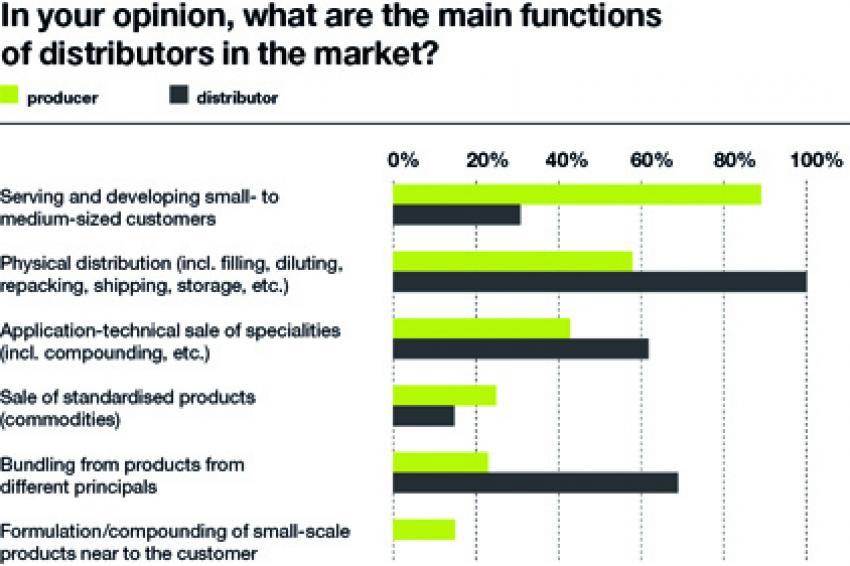Producer-Distributor Relationship in the Supply Chain
14.06.2012 -
Defining Roles - To find out more about how chemical producers and distributors perceive and value their relationship, the Stratley Distribution Survey investigated several aspects of this link. Here is an overview of some of the key results from Stratley, a management consultancy that advises decision makers in the chemical industry worldwide.
The distribution of specialty chemical products plays an important role in the overall supply chain from the chemical industry to its customers. Producers of specialty chemicals (principals) have outsourced some or even all of their distribution activities to companies with specific business models (distributors). Whereas distributors are increasing their geographic spread and application technology knowledge, principals are concentrating more intensely on their production capabilities and selected markets/applications.
This will lead to a clearer differentiation between production and marketing/sales in the chemical industry in the medium to long term, offering various opportunities for mutually beneficial collaboration. However, the daily project work shows that little knowledge of the other side exists, and many prejudices still prevail. Since better collaboration offers value for both parties, the Stratley Distribution Survey was set up - and some of its findings are listed below. The objective was to kick-start the thinking process on both sides and to help spur discussions between principals and distributors.
Distributors' Role in the Market
Given the long history of cooperation between principals and distributors, Stratley did not expect big differences in the views on the role of a distributor in the value chain. However, principals see distributors first and foremost as the only channel to serve small to mid-sized customers. Although this view is clearly understandable, it is a little surprising that the physical distribution itself (ranked second) scores below 60%. By contrast, all the distributors questioned see their role as providing exactly this physical distribution and, to a large degree, bundling products for customers (Figure 1).
Mutual Perception
Principals and distributors have a similar understanding of what counts most: They consider market and application coverage, reputation and existing relationships to be the most important selection criteria. For distributors, a constant search for highly qualified staff with people skills should be a high priority. In addition, retaining good staff with strong principal relationships seems to be crucial to business. They also perceive the diversification of the principals' distributor portfolio as a driver for selection (Figure 2). Principals are much more concerned about market coverage and skill sets.
Distributors And Principals
Principals who see distributors as an extended sales arm miss the opportunity to benefit from their physical infrastructure and knowledge of untapped markets. On the other hand, distributors should, to a larger degree, accept their role as an extended sales arm. Even if their own product lines could prove highly successful, a much greater percentage of their business will result from sales of principals' products. Therefore, distributors should focus on winning over the right principals with appropriate offerings.
General Insights
Stratley's first set of questions covered the collaboration between principals and distributors. Regarding the share of business done via distributors, the majority of respondents put it at between 10% and 20%.
Distributors are managed by principals on a local basis. Because of a broader presence of distributors in the various markets and distributor management becoming a higher priority for business managers, Stratley expects local management to lose share in favor of a more centralized system. The large number of distributors that are used by principals also seems questionable considering that distributors are emerging with supranational capabilities across a diverse set of markets.
In distributor selection management, various ideas should be discussed. For example, the management of these relationships could be improved by setting up a companywide approach to distributor selection in order to bundle sales and by putting a single person in charge. One could also consider regular reviews or performance-oriented tasks to increase quality as well as tracking distributors' performance - including the simple fact of how much business is done with each distributor.
Regarding the latter, the survey shows that distributors can realistically be expected to contribute up to 20% of all new business development. This should represent a good starting point for an ongoing relationship.
Outlook
What does each side see as the other party's major shortcomings? Principals primarily expect distributors to generate more new business and to provide better-qualified staff. On the other hand, distributors particularly expect principals to offer one contact person (instead of several) and to allow them to keep homegrown high-volume customers.
In general, distributors and principals want to continue or expand their business relationships. Therefore, open discussions and better communication could further improve relations - if the other party's perspective is understood and jointly beneficial offerings are developed on this basis.
Having gained a lot of insight into the relationship between distributors and principals, Stratley is happy to share this knowledge. Please contact Stratley for further information.
To order a copy of the Stratley Distribution Survey, please contact Katrin Droischt at dialog@stratley.com.
Contact
Stratley AG
Spichernhöfe Spichernstraße 6A
50672 Köln
Germany
+49 221 977 655 0






